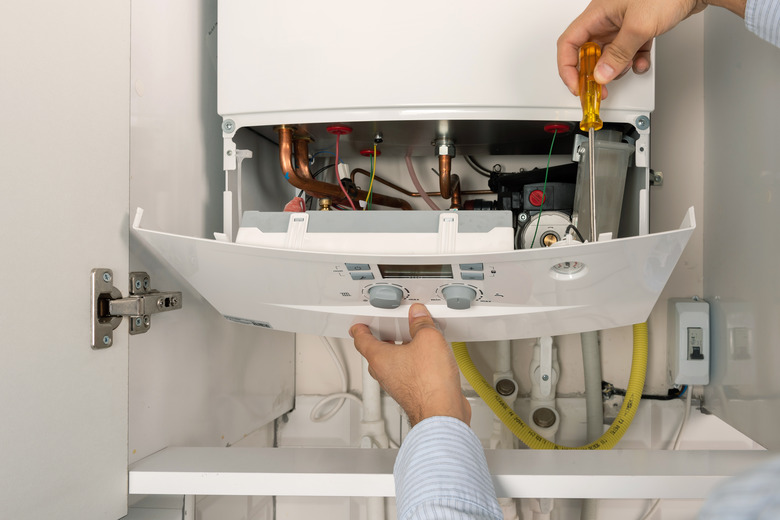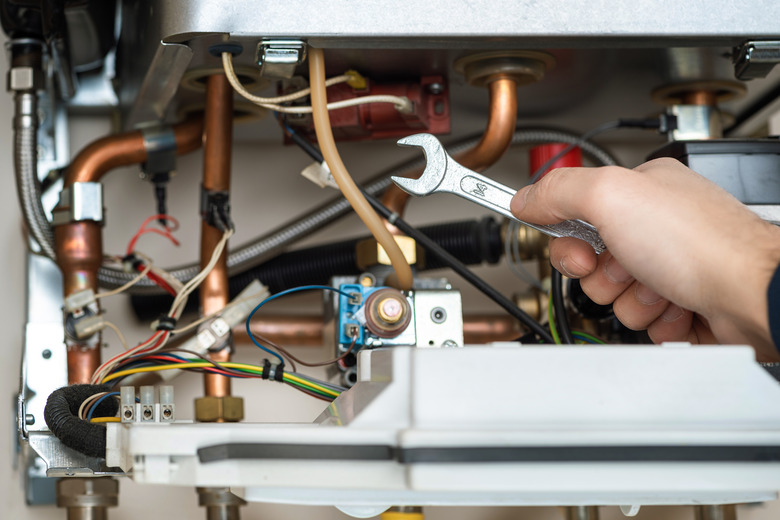What To Expect During A High-Efficiency Furnace Annual Checkup
We may receive a commission on purchases made from links.
High-efficiency furnaces are those with an annual fuel utilization efficiency rating of 90 or higher, which means they convert 90 percent or more of the energy of the fuel they burn into usable heat, and some are as much as 97 percent efficient. Comparing high-efficiency furnaces to standard furnaces, which are only 80 percent efficient, is like comparing Lamborghinis to Toyotas. Both need regular maintenance, but a Lamborghini needs a little more because it is such a finely tuned, high-performance vehicle.
Among the many high-performance features you are likely to find on a high-efficiency gas furnace are a secondary heat exchanger (which extracts extra heat from the fuel by condensing combustion gases into liquid form), a variable-speed blower motor, a multistage burner and an efficient, waste-free ignition system. These and other parts depend on regular furnace maintenance to stay in top form and continue delivering the efficiency you expect. Yearly maintenance is so important for high-efficiency furnaces (also known as condensing furnaces) that skipping it often voids the warranty.
Homeowners can and should complete several maintenance tasks themselves, such as replacing the furnace filter and checking the vents, but it takes an HVAC pro with the right equipment and know-how to test crucial components, such as the ignitor, various switches and sensors and the burners. A high-efficiency furnace is a sealed system, and a pro can recognize issues — like cracks, leaks or a blockage in the vents or drain — that could lead to serious problems, such as the release of carbon monoxide into the warm air, which could be circulated through the ductwork.
Top Checkup Items for High-Efficiency Furnaces
Top Checkup Items for High-Efficiency Furnaces
An HVAC technician will have a checklist of items to clean and inspect when conducting a yearly maintenance tune-up. Top items on the list usually include:
- Primary heat exchanger: A cracked heat exchanger is one of the more serious problems that afflict high-efficiency furnaces, so that's usually the top item slated for inspection. With the gas turned off and the blower running, an HVAC tech can conduct a static pressure test by putting a burning match into each burner cavity and watching what happens. If the flame flickers or goes out, that's a sign that air is blowing into the cavity when it shouldn't be, and the tech will then use mirrors and cameras to locate the crack.
- Secondary heat exchanger: This is a series of smaller tubes that can get blocked by carbon deposits, which is symptomatic of burner problems. The inspector will verify that condensate is draining properly into the furnace drain and that the drains are open and unclogged.
- Blower and blower motor: A thorough inspection of the blower includes removing the blower wheel, cleaning it, checking it for defects and checking the operation of the motor using a meter to measure how many amps of current it draws and comparing that to the manufacturer's specifications. The inspection also includes lubricating the blower motor (as applicable) and checking the blower access door for leaks because furnace efficiency suffers if the furnace isn't properly sealed.
Checking the Gas and Electrical Systems
Checking the Gas and Electrical Systems
The burners on many furnace models are removable, so a tune-up usually includes taking out each one, inspecting it for cracks and cleaning off carbon deposits. After cleaning and replacing the burners, the tech will measure the gas pressure at the gas valve and then operate the furnace to be sure the ignitor works, that the flame sensor keeps the gas valve open as it's supposed to and that each burner burns with a steady blue flame.
A more thorough test, which will be conducted if the furnace has been running erratically, involves measuring the voltage generated by the flame sensor when the burners are on using a multimeter. The tech normally also checks the operation of the limit switch and the pressure switch, which are safety switches that shut down the furnace in the event of overheating and negative pressure from the vents, respectively. Finally, the inspector should compare the temperature reading on the thermostat to an actual thermometer and recalibrate it if the temperatures are different.
Checking Airflow, Start-Up and Shutdown
Checking Airflow, Start-Up and Shutdown
Although it's usually the homeowner's responsibility to change the air filter, that's also on the list of professional tune-up items because a clean air filter is so vital to proper airflow through the ductwork. The tech will replace the filter if necessary and then fire up the furnace to make sure the start-up sequence proceeds normally and that the ignitor and flame sensor are working as they should. Besides checking the operation of the burners while the furnace is running, the tech will also make sure the draft inducer, which is a fan that blows air into the vents to create a draft that sucks out combustion air, is working.
Proceeding outside, the technician will check airflow at the vent openings and will clean debris and buildup from the vents if it's less than it should be. Without proper venting, the air quality in the combustion chamber is poor, and combustion may be incomplete, so this is an important inspection item. Once this test is complete, the tech will shut down the furnace, making sure it's responsive to the thermostat and that the blower stays on sufficiently long after the burners shut off to completely void the furnace of warm air.
Benefits of an Annual Furnace Checkup
Benefits of an Annual Furnace Checkup
Besides keeping the warranty valid, a number of benefits result from a yearly furnace inspection. High-efficiency furnaces, like high-end automobiles, deliver peak performance when they have regular tune-ups, and for homeowners, that means:
- Lower energy bills: A furnace operating at maximum energy efficiency consumes less fuel.
- Longer service life: By taking care of small problems before they turn into big ones, you can enjoy trouble-free heating and comfort for upward of 30 years. Some furnaces have been known to last as long as 40 years with regular maintenance.
- Reduced risk of a furnace breakdown: There's no more worrying about losing your only source of heat during an Arctic vortex event. You can rest easy knowing your heating system has been checked and is ready to go for the entire winter.
- Safety and peace of mind: A furnace that has been checked and certified to be sealed and leak-free won't trip your carbon monoxide detectors and send you scrambling for an emergency service call or — even worse — send you away until your furnace repair is completed.
If your furnace includes an air conditioning system, the checkup will include inspection of the outdoor unit, including the compressor and condenser coils as well as the evaporator coils, which are typically placed above the furnace in the air plenum.
Whether or not you have a heating/cooling system or just a furnace, the technician who does the inspection will check the ductwork for leaks and possible problems that could cause leaks in the future and will patch any leaks found as well as identify any metal ducts in which condensation has been found. That's another important item on the inspection checklist that ensures the system is operating at maximum efficiency and delivering clean, healthy, mold-free air.

